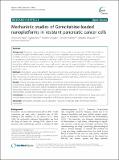Mechanistic studies of Gemcitabine-loaded nanoplatforms in resistant pancreatic cancer cells
Author(s)
Papa, Anne-Laure; Basu, Sudipta; Sengupta, Poulomi; Banerjee, Deboshri; Sengupta, Shiladitya; Harfouche, Rania; ... Show more Show less
Download1471-2407-12-419.pdf (2.047Mb)
PUBLISHER_CC
Publisher with Creative Commons License
Creative Commons Attribution
Terms of use
Metadata
Show full item recordAbstract
Background: Pancreatic cancer remains the deadliest of all cancers, with a mortality rate of 91%. Gemcitabine is considered the gold chemotherapeutic standard, but only marginally improves life-span due to its chemical instability and low cell penetrance. A new paradigm to improve Gemcitabine’s therapeutic index is to administer it in nanoparticles, which favour its delivery to cells when under 500 nm in diameter. Although promising, this approach still suffers from major limitations, as the choice of nanovector used as well as its effects on Gemcitabine intracellular trafficking inside pancreatic cancer cells remain unknown. A proper elucidation of these mechanisms would allow for the elaboration of better strategies to engineer more potent Gemcitabine nanotherapeutics against pancreatic cancer. Methods: Gemcitabine was encapsulated in two types of commonly used nanovectors, namely poly(lactic-co-glycolic acid) (PLGA) and cholesterol-based liposomes, and their physico-chemical parameters assessed in vitro. Their mechanisms of action in human pancreatic cells were compared with those of the free drug, and with each others, using cytotoxity, apoptosis and ultrastructural analyses. Results: Physico-chemical analyses of both drugs showed high loading efficiencies and sizes of less than 200 nm, as assessed by dynamic light scattering (DLS) and transmission electron microscopy (TEM), with a drug release profile of at least one week. These profiles translated to significant cytotoxicity and apoptosis, as well as distinct intracellular trafficking mechanisms, which were most pronounced in the case of PLGem showing significant mitochondrial, cytosolic and endoplasmic reticulum stresses. Conclusions: Our study demonstrates how the choice of nanovector affects the mechanisms of drug action and is a crucial determinant of Gemcitabine intracellular trafficking and potency in pancreatic cancer settings.
Date issued
2012-09Department
Harvard University--MIT Division of Health Sciences and TechnologyJournal
BMC Cancer
Publisher
BioMed Central Ltd.
Citation
Papa, Anne-Laure et al. “Mechanistic Studies of Gemcitabine-loaded Nanoplatforms in Resistant Pancreatic Cancer Cells.” BMC Cancer 12.1 (2012): 419. Web. 18 Jan. 2013.
Version: Final published version
ISSN
1471-2407